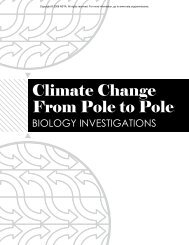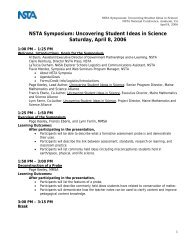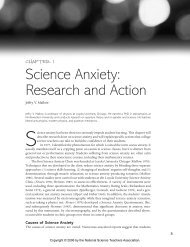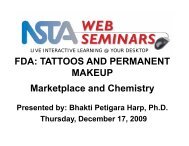Copyright © 2008 NSTA. All rights reserved. For more information ...
Copyright © 2008 NSTA. All rights reserved. For more information ...
Copyright © 2008 NSTA. All rights reserved. For more information ...
You also want an ePaper? Increase the reach of your titles
YUMPU automatically turns print PDFs into web optimized ePapers that Google loves.
Section 1 The Nature of Science and Science Inquiry<br />
6<br />
7.<br />
8.<br />
9.<br />
10.<br />
<strong>Copyright</strong> <strong>©</strong> <strong>2008</strong> <strong>NSTA</strong>. <strong>All</strong> <strong>rights</strong> <strong>reserved</strong>. <strong>For</strong> <strong>more</strong> <strong>information</strong>, go to www.nsta.org/permissions.<br />
activity before they are introduced to the<br />
content.<br />
Provide time for students to “mess<br />
about” with the materials before they<br />
begin their investigation.<br />
Provide students with options of what<br />
or how they investigate.<br />
hold a “scientist meeting” prior to the ac-<br />
tivity to discuss possible questions for investigation<br />
or investigation procedures.<br />
hold a “scientist meeting” after the activ-<br />
ity to discuss outcomes, conclusions and<br />
supporting evidence.<br />
What Skills Do Students Need?<br />
Students need to develop a variety of skills to<br />
fully participate in inquiry.<br />
• Students should have frequent opportunities<br />
to observe objects and events. Good<br />
observations should include <strong>information</strong><br />
gathered from multiple senses and may<br />
involve scientific instruments.<br />
• Students should make educated guesses,<br />
or inferences, based on observations.<br />
• Students should be able to measure using<br />
standard (including metric) and nonstandard<br />
tools.<br />
• Students should be able to classify objects or<br />
events into categories based on criteria.<br />
• Students should be able to use words,<br />
symbols and graphical representations of<br />
data to communicate ideas.<br />
• Students should be able to interpret data by<br />
organizing data and identifying patterns.<br />
Table 2 describes age-appropriate performances<br />
for each of these skills.<br />
What Is the Experimental<br />
Method?<br />
one process by which scientists create new<br />
knowledge is called the experimental method. It<br />
consists of a series of well-defined steps that<br />
test one aspect of a phenomenon while holding<br />
the others constant. Many K–12 textbooks call<br />
the experimental method the scientific method,<br />
This is not accurate, however, because the experimental<br />
method is only one of the processes<br />
that scientists use.<br />
The experimental method involves the following<br />
steps:<br />
1.<br />
2.<br />
3.<br />
4.<br />
5.<br />
Identifying a problem that can be investigated<br />
and determining the independent<br />
and dependent variables. Independent<br />
variables are those that can be easily<br />
changed or controlled. Dependent variables<br />
are those that are affected by the<br />
independent variables.<br />
Stating a hypothesis. experimenters<br />
should pick one independent variable<br />
and one dependent variable to test. They<br />
should then create a statement of how<br />
the independent variable will affect the<br />
dependent variable.<br />
Testing a hypothesis. experimenters design<br />
a “fair test” of their hypothesis. In a fair<br />
test, the independent variable is changed,<br />
the dependent variable is measured and the<br />
other variables are held constant.<br />
Analyzing results. Students try to make<br />
sense of their data.<br />
communicating conclusions. Students<br />
compare their results to their initial hypothesis<br />
and communicate their results.<br />
Table 3 describes age-appropriate experimentation.<br />
NATIoNAL ScIeNce TeAcheRS ASSocIATIoN







